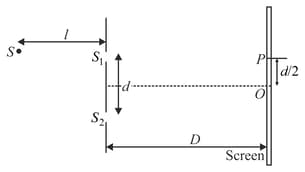The angular width of the central maximum in a single slit diffraction pattern is . The width of the slit is . The slit is illuminated by monochromatic plane waves. If another slit of same width is made near it, Young’s fringes can be observed on a screen placed at a distance from the slits. If the observed fringe width is , what is slit separation distance? (i.e., distance between the centres of each slit.)

Important Questions on Wave Optics
This question has Statement-1 and Statement-2. Of the four choices given after the statements, choose the one that best describes the two statements.
Statement-1: Out of radio waves and microwaves, the radio waves undergo more diffraction.
Statement-2: Radio waves have greater frequency compared to microwaves.
An observer is moving with half the speed of light towards a stationary microwave source emitting waves at frequency . What is the frequency of the microwave measured by the observer? (Speed of light is ).
Two parallel beams of light and (separation ) containing radiations of wavelengths and (which are mutually coherent in each wavelength separately) are incident normally on a prism as shown in the figure. The refractive index of the prism as a function of wavelength is given by the relation, where is in and is a positive constant. The value of is such that the condition for total reflection at the face is just satisfied for one wavelength and is not satisfied for the other. A convergent lens is used to bring these transmitted beams into focus. If the intensities of the upper and the lower beams immediately after transmission from the face , are and respectively, find the resultant intensity at the focus.

White coherent light is sent through the slits of a Young’s double-slit experiment (as shown in the figure). The separation between the slits is and the screen is away from the slits. There is a hole in the screen at a point away (along the width of the fringes) from the central line.
For which wavelength(s) there will be minima at that point?
Which wavelength(s) will have a maximum intensity?
A beam of light consisting of two wavelengths, and is used in a double slit experiment The distance between the slits is and the distance between the plane of the slits and the screen is
Find the distance of the third bright fringe on the screen from the central maximum for the wavelength
What is the least distance from the central maximum where the bright fringes due to both the wavelengths coincide?
A source is kept directly behind the slit in a double-slit apparatus. Find the phase difference at a point which is equidistant from and What will be the phase difference at if a liquid of refraction index is filled; (wavelength of light in air is due to the source). Assume same intensity due to and on screen and position at the liquid.

between the screen and the slits.
between the slits and the source . In this case find the minimum distance between the points on the screen where the intensity is half the maximum intensity on the screen.
